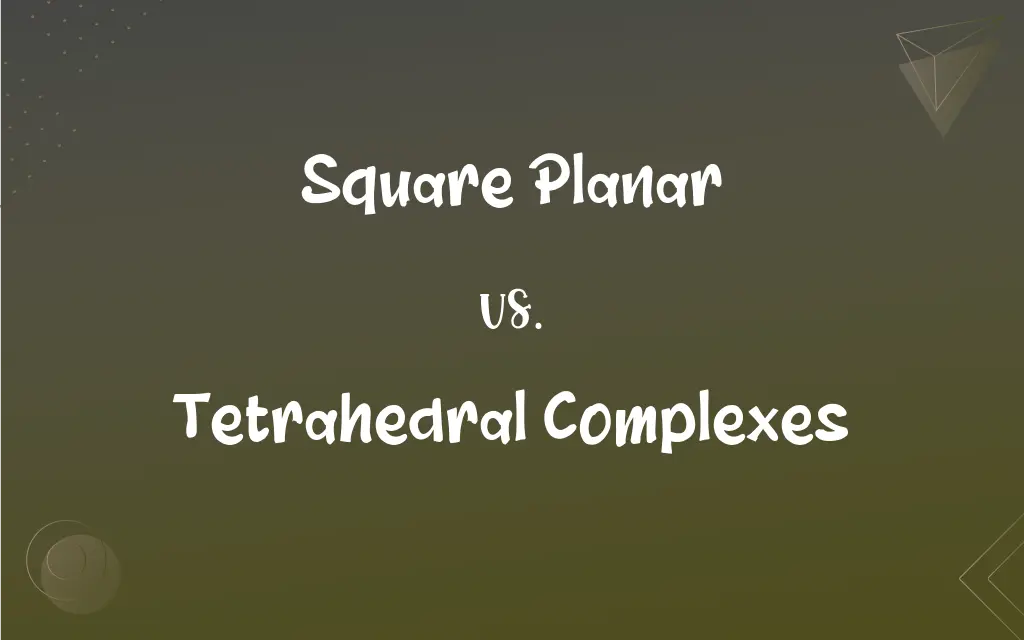Square Planar vs. Tetrahedral Complexes: What's the Difference?
Edited by Aimie Carlson || By Janet White || Published on July 14, 2024
Square planar complexes feature a central atom surrounded by ligands in a square plane, whereas tetrahedral complexes have ligands arranged in a tetrahedron. The former is common in d8 metal ions, while the latter is found in sp3 hybridized centers.

Key Differences
Square planar and tetrahedral complexes differ primarily in their spatial arrangement around a central atom. Square planar complexes, often formed by d8 metal ions like Pt(II) and Pd(II), have their ligands positioned at the corners of a square. Tetrahedral complexes, on the other hand, have their ligands arranged in a three-dimensional tetrahedron around the central atom. This structure is common in sp3 hybridized atoms, including many transition metals and nonmetals, and is favored by high-spin configurations with weak field ligands.
The geometry of these complexes affects their chemical properties and reactivity. Square planar complexes are often associated with geometric isomerism and have a planar structure that can lead to cis-trans isomerism. Tetrahedral complexes, with no plane of symmetry, rarely exhibit this type of isomerism.
Electronically, square planar complexes are usually low-spin due to the strong field ligands causing a large splitting in the d-orbitals. This leads to paired electrons in lower energy orbitals. Tetrahedral complexes typically have high-spin configurations because the smaller splitting of d-orbitals in this geometry does not favor electron pairing.
In terms of color and magnetic properties, square planar complexes tend to be diamagnetic and can show vivid colors due to d-d transitions. Tetrahedral complexes are more likely to be paramagnetic, reflecting the unpaired electrons in their structure.
Comparison Chart
Geometry
Square plane around central atom
Tetrahedron around central atom
ADVERTISEMENT
Common Central Atoms
D8 metal ions (e.g., Pt(II), Pd(II))
Sp3 hybridized atoms (transition metals, nonmetals)
Spin Configuration
Usually low-spin
Usually high-spin
Isomerism
Geometric isomerism possible (cis-trans)
Rarely exhibits geometric isomerism
Magnetic Properties
Often diamagnetic
Typically paramagnetic
Square Planar and Tetrahedral Complexes Definitions
Square Planar
A spatial arrangement important in crystal field theory for explaining bonding in metal complexes.
The square planar arrangement minimizes electron repulsion in certain metallic complexes.
ADVERTISEMENT
Tetrahedral Complexes
In coordination chemistry, complexes that feature a central metal atom surrounded by ligands in a tetrahedral geometry.
Zinc sulfide forms tetrahedral complexes, which are crucial in its semiconductor properties.
Square Planar
In chemistry, a molecular geometry where a central atom is surrounded by four atoms in a square plane.
The coordination complex exhibited a square planar geometry, indicating strong field ligands.
Tetrahedral Complexes
A geometric arrangement resulting from sp3 hybridization in chemistry.
The sp3 hybridization in water molecules leads to a distorted tetrahedral shape due to the lone pairs.
Square Planar
A geometric shape with four sides of equal length and angles, forming a flat square surface.
The artist's rendering of the garden featured a square planar layout for the flower beds.
Tetrahedral Complexes
A molecular structure where a central atom is bonded to four other atoms placed at the corners of a tetrahedron.
The methane molecule is a prime example of tetrahedral complexes in organic chemistry.
Square Planar
A type of molecular structure typical in transition metal complexes with d8 electron configuration.
Nickel(II) complexes often adopt a square planar configuration due to their electronic structure.
Tetrahedral Complexes
A spatial configuration important for understanding the stereochemistry of molecules.
The tetrahedral complexes formed by carbon atoms are foundational to the 3D structure of organic compounds.
Square Planar
In 2D design, a plan that is constrained to two dimensions, emphasizing length and width.
For his project, he designed a square planar figure that could be easily replicated in tiles.
Tetrahedral Complexes
In crystallography, a unit cell structure where atoms are located at the tetrahedron's corners.
Silicon dioxide crystals exhibit a network of tetrahedral complexes, giving them unique optical properties.
FAQs
Are tetrahedral complexes usually high-spin or low-spin?
Tetrahedral complexes are usually high-spin due to the smaller splitting of d-orbitals in this geometry.
What is the main difference between square planar and tetrahedral complexes?
The main difference lies in their molecular geometry; square planar complexes have a planar arrangement of ligands, whereas tetrahedral complexes have a three-dimensional arrangement.
Which type of complexes is more likely to exhibit cis-trans isomerism?
Square planar complexes are more likely to exhibit cis-trans isomerism due to their planar structure.
Can both square planar and tetrahedral complexes be formed by transition metals?
Yes, both geometries can be formed by transition metals, but the specific geometry depends on the metal ion's electron configuration and the ligands' field strength.
What role do square planar complexes play in catalysis?
Square planar complexes often act as catalysts in organic synthesis, including processes like hydrogenation and cross-coupling reactions.
Can square planar complexes undergo d-d transitions?
Yes, they can undergo d-d transitions, which can result in colorful compounds.
Why are square planar complexes often diamagnetic?
They are often diamagnetic because the d8 configuration typically results in all electrons being paired.
Why are tetrahedral complexes typically paramagnetic?
They are usually paramagnetic due to the presence of unpaired electrons in high-spin configurations.
Is it possible for a square planar complex to become tetrahedral?
Yes, under certain conditions, such as ligand substitution, a square planar complex may convert to a tetrahedral geometry.
How does the electron configuration of the central atom affect the geometry of the complex?
The electron configuration determines the distribution of electrons among the d-orbitals, influencing whether a square planar or tetrahedral geometry is more energetically favorable.
How do ligands influence the geometry of a complex?
Ligands influence the geometry through their field strength; strong field ligands tend to produce square planar complexes, while weak field ligands favor tetrahedral complexes.
What impact does the geometry of a complex have on its chemical reactivity?
The geometry affects reactivity, with square planar complexes often being more reactive in substitution reactions compared to tetrahedral complexes.
What are some common ligands for square planar complexes?
Common ligands include CN-, NH3, and PPh3, known for their strong field characteristics.
Are there specific rules for predicting the geometry of a metal complex?
Yes, the geometry can often be predicted based on the metal's electron configuration, the ligands' field strength, and the principles of crystal field theory.
Can environmental factors influence the geometry of a complex?
Yes, factors like temperature, pressure, and solvent can influence the stability and thus the geometry of a complex.
Can the geometry of a complex influence its solubility?
Yes, the geometry can influence solubility, as it affects the overall shape and size of the molecule, which in turn influences how it interacts with solvents.
How do square planar and tetrahedral complexes differ in terms of their formation conditions?
Square planar complexes typically form under conditions favoring strong field ligands and low-spin configurations, whereas tetrahedral complexes form with weak field ligands and high-spin configurations.
How does the hybridization of the central atom differ between square planar and tetrahedral complexes?
In square planar complexes, the central atom typically exhibits dsp2 hybridization, while in tetrahedral complexes, it exhibits sp3 hybridization.
About Author
Written by
Janet WhiteJanet White has been an esteemed writer and blogger for Difference Wiki. Holding a Master's degree in Science and Medical Journalism from the prestigious Boston University, she has consistently demonstrated her expertise and passion for her field. When she's not immersed in her work, Janet relishes her time exercising, delving into a good book, and cherishing moments with friends and family.
Edited by
Aimie CarlsonAimie Carlson, holding a master's degree in English literature, is a fervent English language enthusiast. She lends her writing talents to Difference Wiki, a prominent website that specializes in comparisons, offering readers insightful analyses that both captivate and inform.






































































